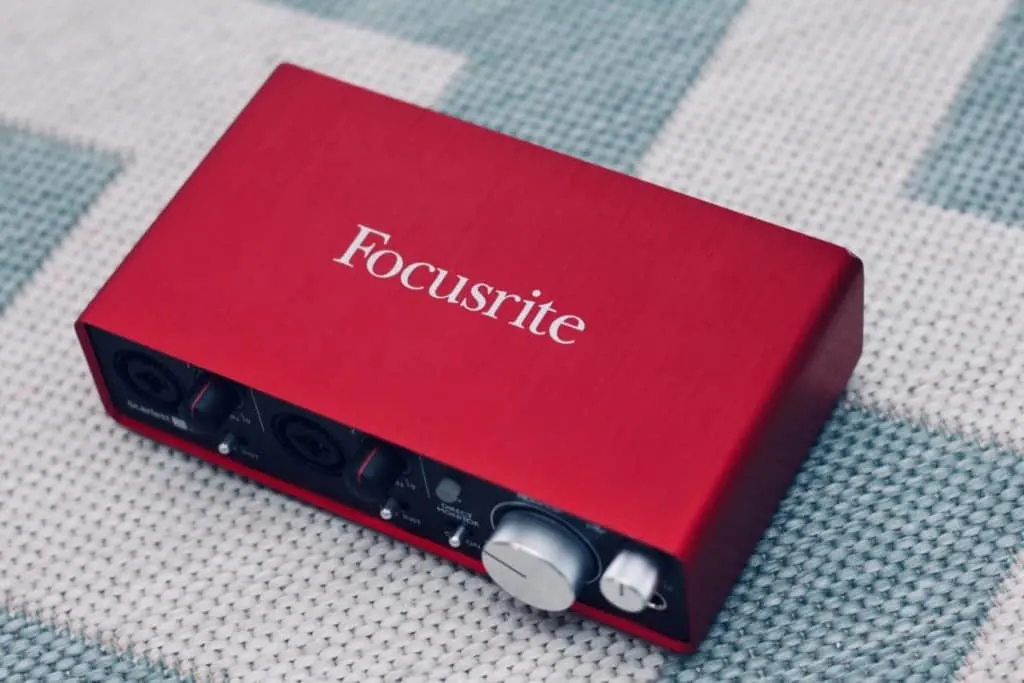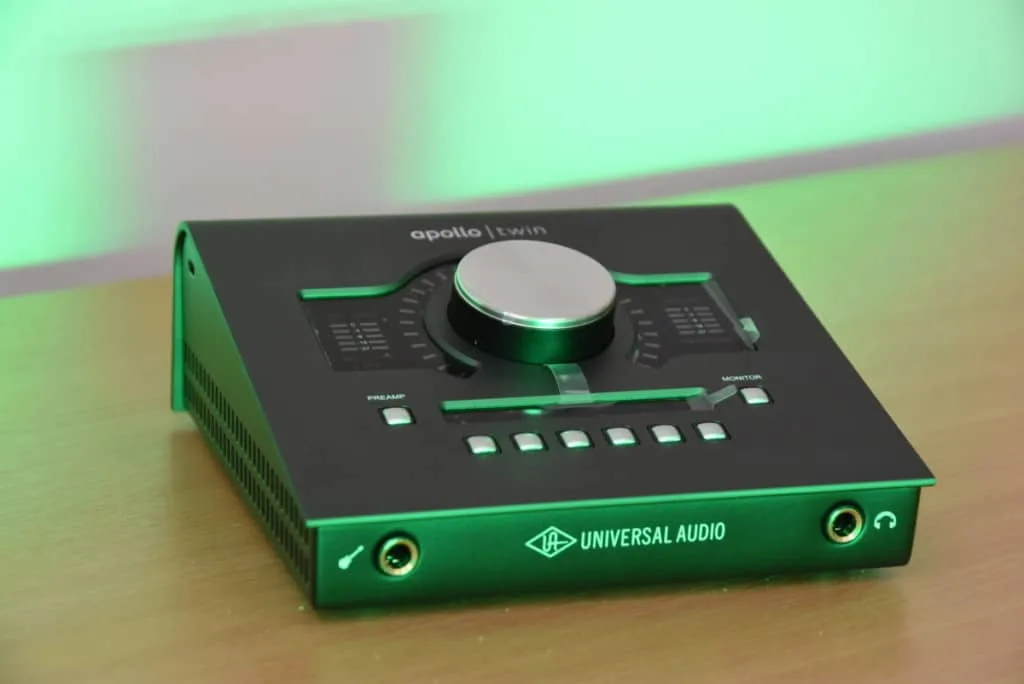Audio interfaces are an essential component of a digital recording setup. They provide numerous benefits, allowing you to record microphones and instruments, and also controlling monitoring.
Will an audio interface reduce latency?
In the majority of cases, an audio interface will reduce latency. Audio interfaces are generally more efficient than a computer or laptop’s inbuilt sound driver. High-end audio interfaces have the ability to massively reduce latency, while lesser quality ones still reduce it significantly.
Latency is an issue that can be caused by several factors.
The most common cause is a sub-par output device, which can’t process the audio quickly enough, causing lag. Thankfully, there are many good quality audio interfaces out there that can lessen latency, or remove the issue altogether.
In this comprehensive guide, I’ll explain how an audio interface can reduce latency.

What Is Audio Latency?
We’ll get into the ways that audio interfaces can reduce latency shortly, but first, let’s take a look at what audio latency is, and why it occurs in the first place.
Put simply, audio latency is the period between audio being played, and the audio being heard.
For example, if you were to play a chord on a MIDI keyboard, the latency would be the time gap between the keys being struck, and the sound being played back through your monitors or headphones.
If you’ve experienced latency when producing music, you’ll know how frustrating it can be. It makes playing in time very difficult because you have to anticipate the lag between pressing the keys and hearing the sound.
- In some cases, if latency is very bad, it can make recording almost impossible.
Modern music production predominantly relies on digital technology. This has many benefits regarding convenience and affordability, and it has made the act of recording accessible to everyone who owns a laptop and an audio interface.
Despite the undeniable benefits that digital recording has created, there are some downsides.
One of these is the inevitability of latency. This is caused due to the digital audio being processed. An example of this is when you record vocals using a condenser microphone and an audio interface.
When vocals are recorded, the singer projects their voice into the microphone capsule. An analog signal is created, which is sent through the XLR cable into the audio interface. Then, the DAC within the audio interface converts the signal from analog to digital.
The digital signal then travels to the computer or laptop, via USB or FireWire connection. It is then processed and recorded into your chosen DAW, where it can be subjected to plugins and effects.
Then, the digital signal is sent back to the audio interface, where the DAC converts it back to analog. Finally, the analog audio waveform is played back through the monitors or headphones.
If you are new to recording feel free to check out my beginner’s guide to using an audio interface. You can read it here
When the process of recording is broken down into its parts, it’s easy to see why latency could easily occur. The signal must travel through many different components, be converted multiple times, and then be returned to the audio interface for playback.
If you’re relying on a sub-par audio interface, latency is likely to be a real issue.
However, the good news is, there are plenty of audio interfaces on the market that process the audio very efficiently and quickly, thus minimizing latency and creating a better recording environment.
One popular audio interface is the Focusrite Scarlett range (pictured above)
Check out this audio interface here on Amazon.
How Audio Interfaces Reduce Latency
The ability that an audio interface has to reduce latency varies from model to model.
Like any piece of audio equipment, interfaces are vastly different in terms of quality. A low-priced, basic audio interface may reduce latency slightly, but it is unlikely to solve the problem completely.
Computers and laptops are designed to be multi-functional. They can be used for a plethora of purposes, including music production, video editing, and image editing, or gaming. Therefore, the internal parts that are installed by the manufacturer aren’t solely focused on one of these areas.
The quality of the audio drivers installed in a computer isn’t necessarily well suited to music production.
Although they can hold their own to an extent, relying on the onboard drivers will likely lead to latency. Audio interfaces are capable of resolving this issue.
Audio interfaces are built for a singular purpose – to facilitate music production, in terms of both playback and recording. The components used to build them are superior compared to the standard, inbuilt drivers in a laptop or computer.
- When you select an audio interface as the input and output device within your DAW, you effectively bypass the onboard sound drivers.
The interface takes on the burden of playback and recording. Providing you’re using a decent quality audio interface, any latency issues should be instantly improved when the sound drivers are overridden.
Before you rush off to purchase the first audio interface that you can find, it’s important to emphasize the point that not all interfaces are created equal.
Generally, using any audio interface will offer improvements regarding latency, in comparison to the onboard sound drivers of a computer or laptop.
Nevertheless, audio interfaces vary significantly from model to model in terms of their ability to reduce latency time. To illustrate this point, the table below shows the average latency time of several popular audio interfaces at 512 samples, 44.1kHz using a Windows 10 computer.
| Audio Interface | RTL |
| Clarett 2 Pre USB | 47 ms |
| Track16 | 38 ms |
| Fireface UFX | 25 ms |
| Audio Hub 2×4 | 43 ms |
| U-Control UCA222 | 38 ms |
As you can see, the latency time varies quite significantly depending on the audio interface that is used.
Compared to the latency that occurs when relying solely on the sound drivers of the computer, each of the above interfaces produces a marked improvement.
Unfortunately, it’s not just as simple as choosing any audio interface to solve the problem of latency.
Even 25 ms causes noticeable delays between the sound being triggered, and its playback. To understand why this happens, we must further investigate the other causes of latency.
Choosing Gear Can Be Really Hard!
Home recording requires a whole series of equipment, and it can be difficult to do the research to figure out exactly what to buy depending upon your budget.
I have written a complete guide to exactly which equipment you should get depending on your budget.
Audio Buffers
For a computer to playback or record audio, a multitude of behind-the-scenes processes takes place. When you add processing, effects, and VST plugins into the mix, the CPU is put under a significant amount of stress.
An integral mechanism that allows music production to be possible is the audio buffer.
An audio buffer allows the computer to run smoothly when it is strained by the process of music production. However, there is a trade-off. While the buffer has numerous benefits, it is often also a main cause of latency. Thankfully, you can change the buffer settings to improve this issue.
The buffer settings can be changed within the preferences section of your chosen DAW. These settings instruct your computer or laptop’s RAM to dedicate a section of its memory to store the audio samples that are constantly played.
Even if you’re using a high-end audio interface, you’ll still experience latency if you don’t establish the optimal buffer settings for your system. This is intrinsically linked to the subject of audio samples.
This video thoroughly explains the relationship between buffer settings, sample rates, and audio interfaces.
When audio is processed by the interface and the computer, it is broken down into segments that are converted into digital information.
Audio samples that have a higher sample rate are simply more detailed, and therefore can be played back at a higher resolution.
The standard sample rate for recording is 44.1 kHz. For audiophiles who want to ensure that their recordings are of the highest quality for mixing and mastering, 96 kHz is commonly used.
Buffer sizes, along with sample rate, largely impact the performance of an audio interface and the computer in general. The choice of buffer size ranges from:
- 64
- 128
- 256
- 512
- 1,024
- 2,048
These numbers describe the number of samples that your buffer is capable of holding. This essentially allows your CPU to calculate output latency. In most popular DAWs, you are presented with the exact latency time in milliseconds.
One popular audio interface is the Apollo Twin. Check out the Apollo twin here on Amazon.

When your audio interface is connected to the computer or laptop, you can adjust the buffer size and sample rate settings to determine what the most effective settings are for reducing latency.
I have written an article on connecting an audio interface to an iPhone. You can read it here.
Related Questions
What is acceptable audio latency?
It’s practically impossible to completely remove audio latency. With that being said, moderate amounts of latency shouldn’t negatively impact recording or playback too much. Around 8-12 ms of latency is a desirable amount.
Does direct monitoring reduce latency?
Audio interfaces that are capable of direct monitoring remove the issue of latency when recording. This feature will not reduce latency when audio is played back, but it allows you to hear your recorded audio in real-time whilst bypassing the processor in your computer.
Are USB or FireWire audio interfaces better at reducing latency?
The difference between USB and FireWire audio interfaces when it comes to latency is very minimal. USB 2.0 is likely to suffer a slight increase in latency compared to its FireWire equivalents, due to it having one additional process to convert the audio.
